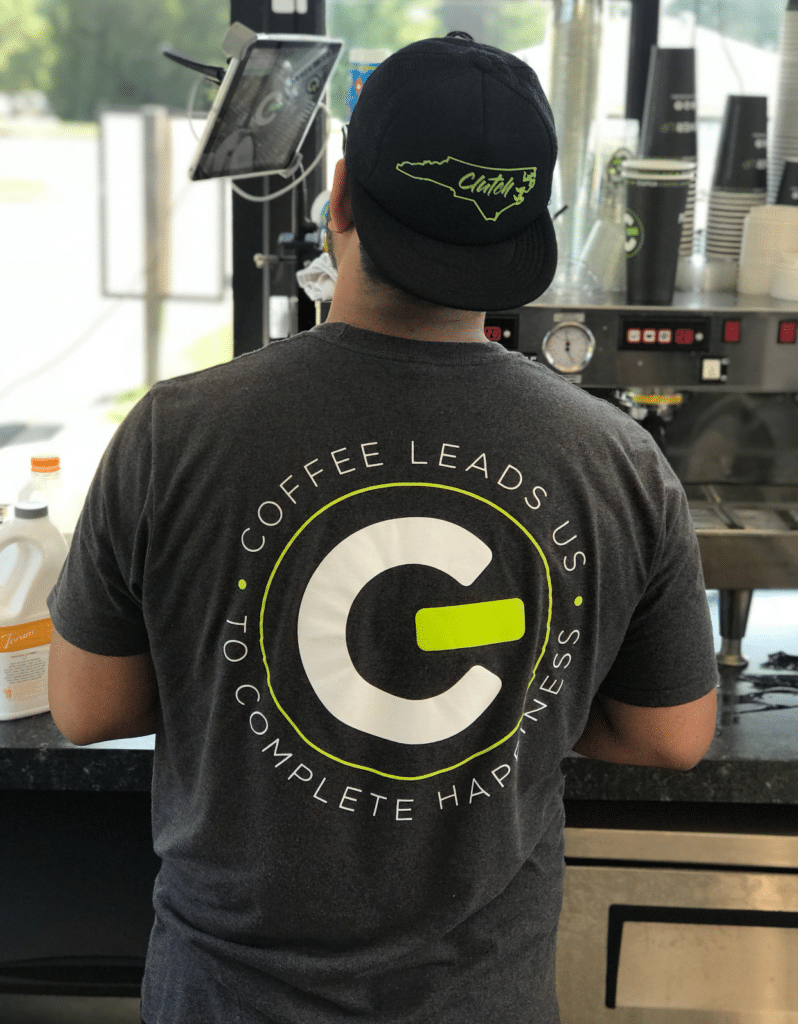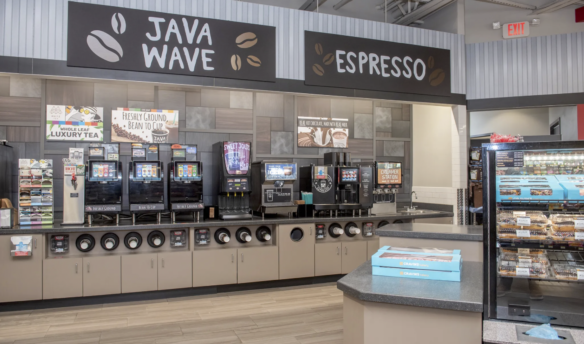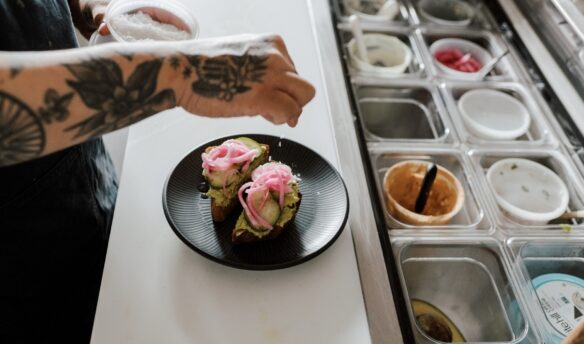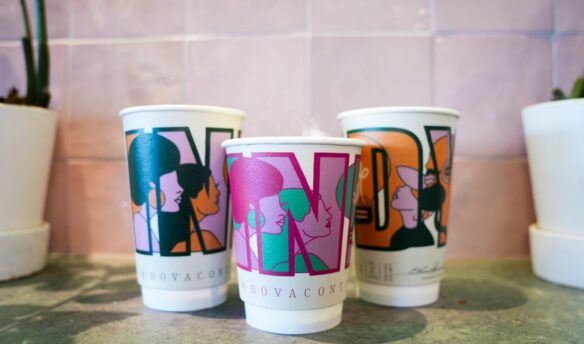Drive-thrus can evoke rushed and impersonal transactions. But folks like Clutch Coffee Bar are reimagining the drive-thru model as a vehicle for fun, friendly, and fast customer experiences.
Growing up in New England, my family and I would stop at Dunkin’ Donuts on the way to school every morning. We’d park the car, walk in, and on the counter was a medium French vanilla coffee with skim milk and two Splenda waiting for my mother. The employees knew her order by heart.
However, our morning ritual shifted when another coffee shop—this time with a drive-thru—opened closer to our home. With two kids’ schedules to juggle on top of her job, the closer shop was undoubtedly a welcome convenience for my mom, and who wouldn’t opt to go to the coffee shop closer to home when wrangling young kids?
But I remember missing the feeling of walking into our regular Dunkin’. The employees would occasionally sneak an extra donut or two into the order just for my sister and me, and snacking on the sugary goodness just before school started was the stuff a seven-year-old’s dreams are made of. Instead, our morning ritual was replaced with quick, impersonal transactions and a few mumbled phrases over an intercom.
My drive-thru memories are probably not uncommon. As more restaurants adopted drive-thru windows, many synonymous with fast food giants and speed, customer service became less of a priority. Rapid transactions, automation, and efficiency are more important when a line of cars is forming around the building. Customers, like my family on our way to school, ultimately became used to distant drive-thru employees who were more focused (understandably so) on getting orders fulfilled and out the window. But drive-thrus are experiencing a resurgence, and some coffee companies, like Clutch Coffee Bar, are reclaiming the drive-thru experience and taking it to an entirely new level.
Next Window Please
We can thank a clown for creating drive-thru restaurants. No, not Ronald. Jack.
Jack in the Box, then called Topsy’s Drive-In, was the first to popularize a drive-thru restaurant concept using the two-way intercom ordering system—you likely know it well: you state your order to a seemingly imaginary person in a box, drive a few feet, and magically, the person has your order ready to go.

According to the National Museum of American History (which has an early Jack in the Box intercom menu board from the 1960s on display), “Founder Robert O. Peterson credits the idea for his burger place with ideas borrowed from other recently opened California burger chains. He noticed that after McDonald’s got rid of carhops their profits soared, and at In-N-Out Burger, a very limited menu seemed to work well. Peterson incorporated both of these ideas (no carhops, limited menu), and focused on developing the model of customers driving up, placing their orders, and then driving away.” The menu board featured a limited menu, along with a menacing clown—the restaurant’s logo—staring menacingly at patrons.
Topsy’s Drive-In, located in San Diego, sparked a wave of drive-thru style restaurants. As the drive-thru concept began to spread throughout the state with help from chains like In-N-Out (who are often credited with being the first to actually implement a drive-thru model with an intercom system in 1948), so did the population’s enthusiasm for convenient drive-thru meals. By the 1970s, drive-thrus were a standard feature of fast food restaurants, including Burger King, McDonald’s, and Wendy’s.
So when does coffee come into the picture?
While iconic carts like Seattle’s Espresso Vivace inspired the grab-and-go coffee movement in the late 1980s, coffee didn’t enter the drive-thru realm until 1990 when Jim Roberts opened Motor Moka in Portland, Oregon. Motor Moka claims to be the world’s first ever drive-thru coffee shop, repurposing what looks to be a former fast food restaurant. The drive-thru coffee concept expanded to several locations across the Portland area—but Roberts recognized that patrons would miss out on the coffee shop experience. So Motor Moka launched a dedicated radio station and poetry magazine to replicate the coffeehouse experience for on-the-go customers.
Although initially resistant to the idea, Starbucks launched its first drive-thru location in 1994 in Southern California. Starbucks’ initial hesitation proved to be unwarranted: the concept was quickly adopted and incorporated into many future sites. According to an August 2022 earnings call, nearly two-thirds of Starbucks orders are placed via drive-thru, mobile app, or delivery services. 90% of all new Starbucks locations include drive-thrus.
What happens with drive-thru is that we’ve become accustomed to [an experience] which is very transactional. The window opens, they take your money, the window closes, their back turns, and they’ll bring your drink back later. That window never closes for us. We are focused on that relationship the entire time. Darren spicer
During the ’90s, another coffee giant quickly gained traction with their drive-thru concept: Dutch Bros. What started as a coffee cart concept throughout Grants Pass, Oregon, transformed into a drive-thru success. “When we figured out [drive-thru] was going to be a niche for us, it was a game changer,” Travis Boersma, CEO of Dutch Bros. Coffee, told Guy Raz on an episode of the “How I Built This” podcast. Today, Dutch Bros. Coffee is on track to have 800 drive-thru locations by the end of 2023.
The success of drive-thrus isn’t slowing down anytime soon. The global COVID-19 pandemic spurred drive-thru’s popularity: drive-thru sales across America increased by 20% from February 2020 to February 2022.
One-Minute Wins
For many restaurants, the drive-thru experience optimizes convenience. You drive up to a menu board with an intercom, loudly state your order (and hope the cashier heard you correctly), and drive around the building to pay and pick up your order. Before you know it, you have your food and drinks in hand.
But drive-thru experiences can feel rushed and hollow, which is something Darren Spicer wanted to tackle at Clutch Coffee Bar, a Carolinas-based coffee company he co-founded in 2018. “What happens with drive-thru is that we’ve become accustomed to [an experience] which is very transactional. The window opens, they take your money, the window closes, their back turns, and they’ll bring your drink back later,” he says. “That window never closes for us. We are focused on that relationship the entire time.”
A typical drive-thru experience at a Clutch begins right as you drive into the lane. Upbeat music plays on outdoor speakers, and instead of yelling your order into an intercom, a barista meets you at your car to chat, take your order, and collect payment. Once you reach the drive-thru window, you’re met by another barista who has your drinks brewed and ready to go.
The model is reminiscent of Chick-fil-A’s drive-thru process, and Clutch has gone all-in on driving through. If you want to park and stretch your legs, you can order at a walk-up window—but there’s no indoor space open to patrons.
We have to nail it all. The speed, the drink, and the service has to be exceptional, above any other place you’re going to go to … We want to make sure the baristas are creating those ‘one minute win’ interactions with customers versus transactions. Morgan Holtz
Ordering coffee is often a hurried process—drive-thru or not—and the Clutch team attempts to maximize employees’ limited time with patrons. “We have to nail it all,” says Morgan Holtz, Clutch’s senior director of growth. “The speed, the drink, and the service has to be exceptional, above any other place you’re going to go to … We want to make sure the baristas are creating those ‘one minute win’ interactions with customers versus transactions.”
But patrons don’t go to a coffee drive-thru for friendly banter; they go to get their coffee quickly. Spicer says that Clutch aims to have a one-minute turnaround time between customers at the window. “Imagine you have a steady line of cars, and car #1 leaves the pick-up window. Our goal is for it to take one minute or less between car #1 leaving the window and car #2 leaving that window,” says Spicer. “We have to be optimized on speed because, at the end of the day, our customers’ most valuable thing is time, and we want to make sure we get them caffeinated and on their way.”
Every element of the drive-thru experience is designed to optimize speed. Employees are assigned to designated positions, from “runners” who take orders in the drive-thru lanes to the baristas brewing espresso and steaming milks for beverages. Part of that speediness also comes from flexibility: Holtz says every Clutch employee is trained across all positions. “One day, [a barista might] be scheduled on the espresso machine pulling shots; one day, they’ll be scheduled on the milk position. One day, they’ll be on the window, and another as a runner.”
Driving Growth
For Clutch, a key element to success is knowing your audience and what your audience wants. Spicer says that much of Clutch Coffee Bar’s customer base skews young, which aligns with current consumer trends. According to a report from the NPD Group, younger audiences are much more likely to seek out “quick service restaurants, particularly fast casual, that balance value and focused menu.”

“The other shift that’s interesting with a younger demographic,” says Spicer, “is a shift from traditional hot coffee to almost exclusively ice and frozen coffee.” Clutch’s menu reflects changing coffee preferences—many of its coffee drinks can be made hot, cold, or frozen, and its online menu features pictures almost entirely of cold beverages, including smoothies, shakes, iced teas, and juices. And this isn’t just something Spicer is noticing with his customers: cold coffee already dominates, and its market share is expected to grow at an annual rate of 22.7% from 2023 to 2028.
Clutch believes deeply in its drive-thru model, so much so that the company is on track to expand to 30 coffee chains in the Carolinas by 2025 (they currently have eight locations, with one on track to open in Lexington, South Carolina, in October 2023). “We definitely want to continue to grow and really try to be that Carolina-born coffee brand,” Spicer says.
While Spicer estimates the company will be well on track to exceed 30 stores in 2025, he reiterates the success of Clutch is due to the face-to-face relationships baristas make with customers. “We really try to make sure that we become a part of any community we go into.”
Holtz echoes Spicer’s sentiment. “What sets Clutch apart is the relationships baristas build with all the customers that come through … Getting to know the customers’ names, their story, and being able to look down the lineup of cars and say, ‘There’s Billy driving up, let’s get his drinks made and ready.'”















